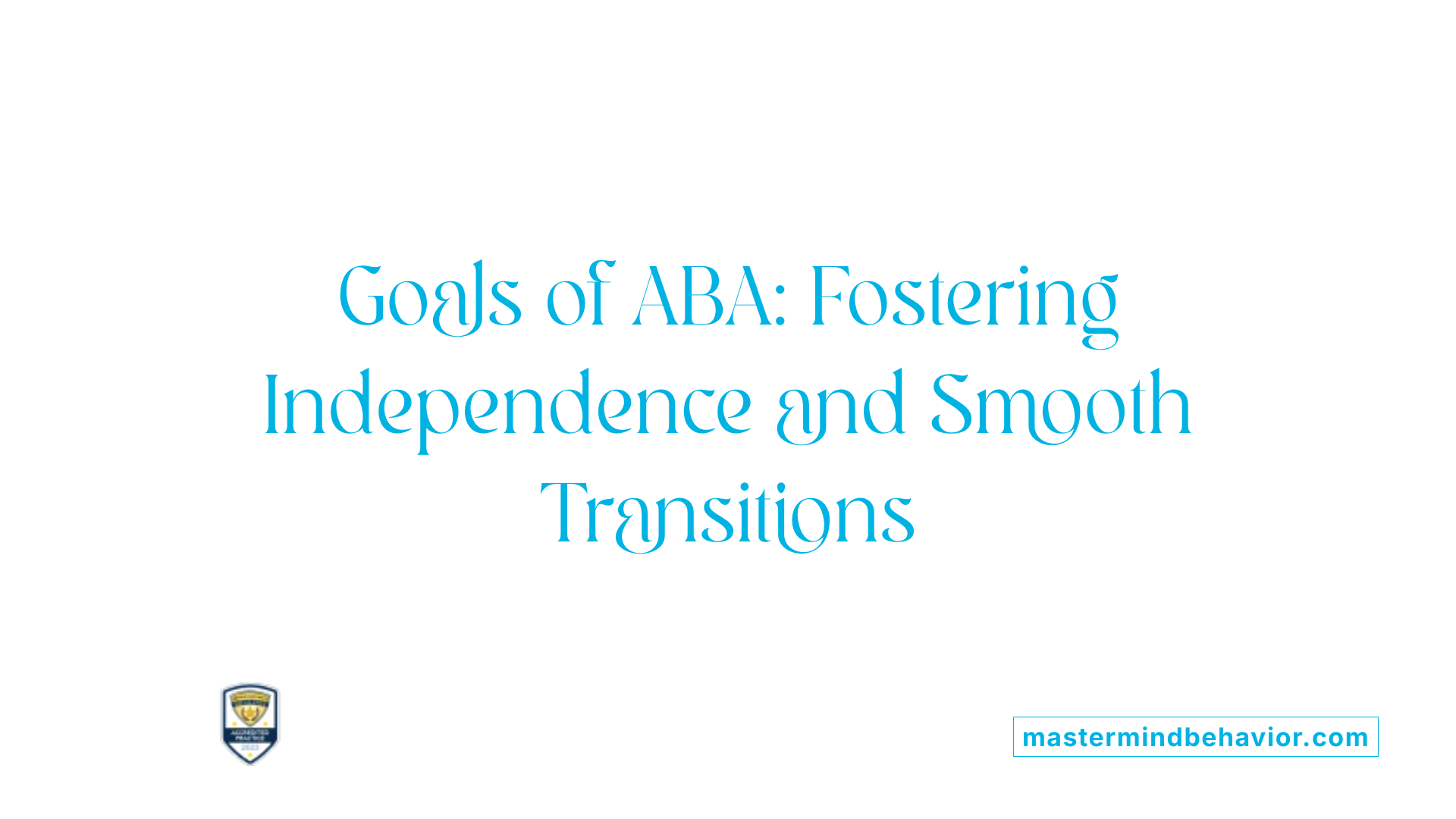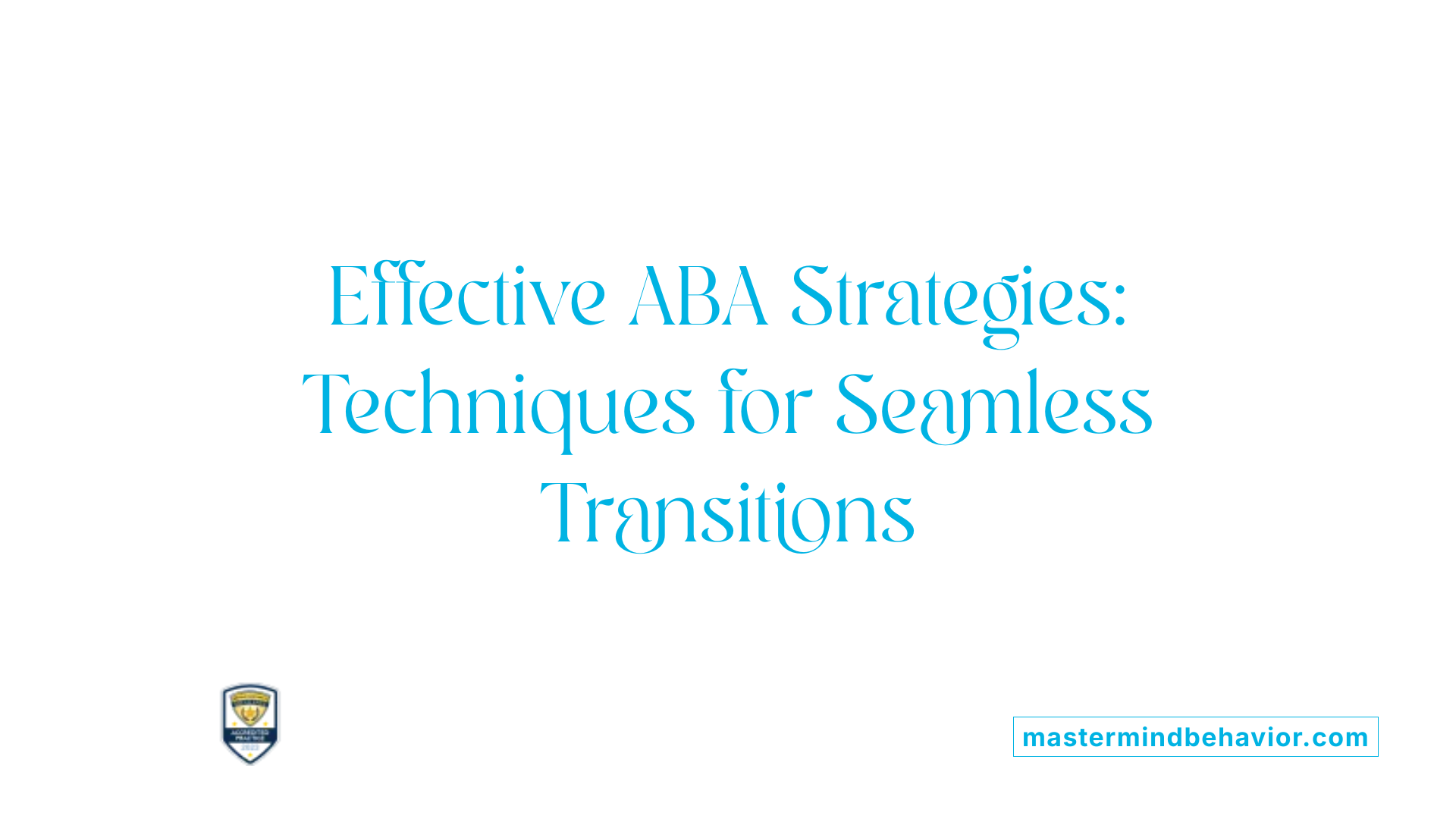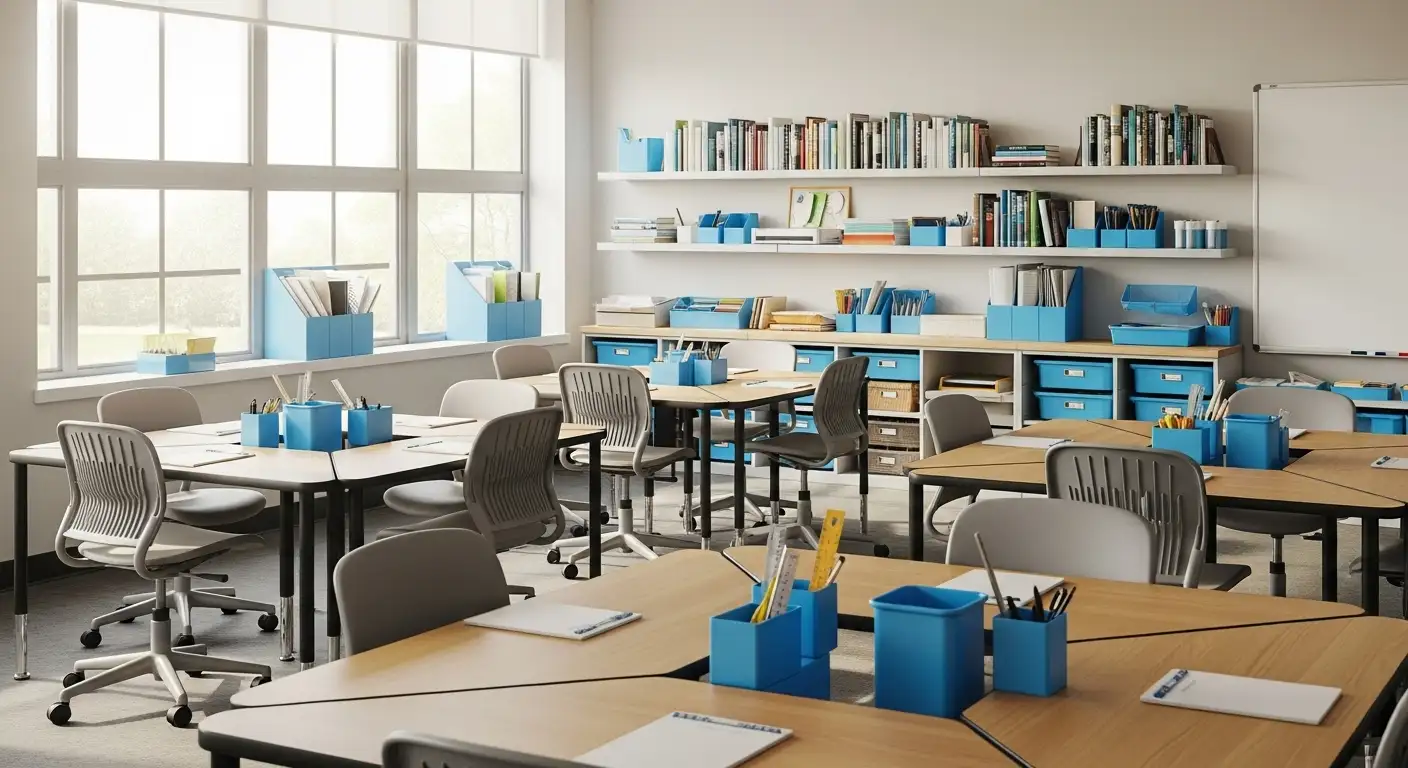How ABA Therapy Improves Transitioning Between Activities

Understanding the Importance of Transitions in Autism Care
Transitions between activities can be particularly challenging for children with autism spectrum disorder (ASD), impacting their behavior and learning. Applied Behavior Analysis (ABA) therapy offers targeted strategies to ease these transitions, enhancing adaptability and independence. This article explores how ABA therapy supports smooth transitions in daily routines and environments, improving the overall quality of life for autistic children and their families.
What Is ABA Therapy and How Does It Support Children with Autism?

What is Applied Behavior Analysis (ABA) therapy and how is it used for autism?
Applied Behavior Analysis (ABA) therapy is a research-based approach that uses the principles of learning and behavior to assist individuals with autism spectrum disorder (ASD). Its goal is to develop essential skills while reducing challenging behaviors by analyzing the relationships between antecedents (what happens before a behavior), the behavior itself, and the consequences that follow. ABA therapy often employs positive reinforcement techniques to encourage desired behaviors, making it a highly effective and personalized treatment.
Definition of ABA Therapy
ABA therapy breaks down complex skills into manageable steps, teaching communication, social skills, self-care routines, and adaptive behaviors systematically. It involves thorough assessments to pinpoint behavioral goals and devises structured plans tailored to each child's unique needs.
Core Focus Areas of ABA Therapy
The therapy emphasizes several critical developmental areas:
- Communication: Teaching expressive language and interpretation of social cues.
- Social Skills: Building friendships, sharing, taking turns, and appropriate social interaction.
- Behavior Management: Utilizing functional assessments to address challenging behaviors like tantrums or self-injury.
- Daily Living Skills: Promoting independence through self-care and routine activities.
Settings Where ABA Therapy is Provided
ABA interventions are flexible and can be delivered in various environments such as the child's home, schools, or community settings. This versatility helps generalize learned skills across different real-life situations, further supporting children's development and adaptation.
Extensive research validates ABA therapy as an effective evidence-based practice, improving communication, social interaction, and overall quality of life for children with autism. Its individualized, data-driven approach ensures continuous monitoring and adjustment of goals, making it a cornerstone in autism treatment strategies.
Who Delivers ABA Therapy and How Is Quality Ensured?

Who provides ABA therapy for autism?
ABA therapy for autism is delivered by a team of trained and certified professionals, foremost among them Board Certified Behavior Analysts (BCBAs). These experts design individualized intervention plans based on thorough assessments. Behavior technicians and therapists, who receive specific training in ABA techniques, often implement these plans during direct therapy sessions. Educators with specialized experience in autism support also contribute to therapy, especially in school settings.
What qualifications and certifications do providers hold?
ABA providers typically hold certifications such as the BCBA credential, which requires rigorous education, supervised experience, and successful completion of a national exam. Behavior technicians often hold Registered Behavior Technician (RBT) certification, ensuring competency in practical ABA skills. Such certifications emphasize adherence to ethical standards and evidence-based methods.
In what settings is ABA therapy delivered?
ABA services are versatile and available across multiple environments, including specialized autism clinics, healthcare facilities, schools, and natural environments like the child's home or community settings. This variety supports the generalization of skills and consistent reinforcement across contexts.
How is quality ensured through accreditation and insurance coverage?
Organizations like the Behavior Health Center of Excellence (BHCOE) accredit ABA providers based on standards of care, staff qualifications, clinical practices, and outcomes measurement. Accreditation assures families of high-quality, accountable services. Many ABA therapy programs accept insurance coverage such as Medi-Cal, which often requires providers to meet specific credentialing and service standards. Referrals from healthcare professionals and agencies help families access reputable providers.
Delivering ABA therapy through qualified professionals who meet strict certification criteria and practice within accredited programs ensures effectiveness and safety. These measures collectively promote positive outcomes, tailored interventions, and continuous progress monitoring aligned with each child's unique needs.
Key Goals of ABA Therapy for Enhancing Daily Transitions

What are the main goals of ABA therapy in treating autism?
ABA therapy primarily aims to facilitate meaningful behavior change by focusing on improving communication, social skills, daily living abilities, and educational achievement. It seeks to increase adaptive behaviors like requesting needs, labeling objects, and engaging positively with peers. These objectives are tailored for each child following detailed assessments and continuous progress monitoring.
Core objectives of ABA therapy
ABA targets enhancing functional communication and social interactions, reducing challenging behaviors, and fostering independence in daily routines. The therapy employs positive reinforcement, functional behavior assessments, and data-driven adjustments to teaching plans. This systematic approach helps children develop skills necessary for smoother transitions, such as moving to a new school environment or adapting after breaks.
Improvement in communication and social skills
ABA breaks communication into smaller, teachable components, using modeling and reinforcement techniques to build expressive language and understanding of social cues. Social skills training focuses on sharing, turn-taking, and responding appropriately, which strengthens peer relationships and improves children's confidence in social settings.
Reduction of challenging behaviors
By conducting thorough functional assessments, ABA identifies triggers for behaviors like tantrums or self-injury and designs behavior intervention plans. This helps children learn self-regulation strategies, manage emotions, and decrease behaviors that interfere with learning and socialization.
Support for independence and adaptive skills
ABA also emphasizes building essential life skills, including self-care and daily routines, fostering greater autonomy. These adaptive skills contribute to smoother daily transitions, enhance children's confidence in new environments, and promote overall well-being.
Together, these goals ensure ABA therapy supports autistic children comprehensively, aiding their development and quality of life across multiple domains.
Techniques and Strategies That Facilitate Smooth Transitions

What techniques and strategies are commonly used in ABA therapy for autism?
ABA therapy uses a range of evidence-based techniques designed to foster meaningful skill development and smooth transitions for children with autism. One foundational method is positive reinforcement, where desired behaviors are encouraged by rewarding them immediately, boosting the likelihood those behaviors will continue.
Another widely used technique is Discrete Trial Training (DTT). This involves breaking down skills into smaller, manageable steps and teaching each step systematically. DTT sessions offer structured, repetitive practice, which helps children master new skills effectively.
Naturalistic interventions, such as Pivotal Response Training, occur in everyday settings. These strategies encourage learning through play and routine activities, helping children generalize skills to various environments.
Behavior chaining and prompting are crucial for teaching sequences of actions. Chaining connects individual steps into a complete task, while prompting gradually reduces assistance, promoting independence.
Visual supports and active parent involvement play a significant role. Using visual aids like picture schedules or token boards helps children understand routines and expectations. Involving parents through goal-setting, training, and participation in sessions reinforces learning and skill transfer at home.
Lastly, data-driven progress monitoring ensures therapy is individualized and effective. Therapists collect and analyze data on each child’s responses to different strategies, enabling timely adjustments to learning goals. This ongoing assessment helps prevent regression, promotes sustained gains, and supports smoother transitions into new settings like school.
These integrated techniques collectively enhance communication, social skills, and daily living abilities, making ABA therapy a comprehensive approach that supports children with autism in adapting confidently across diverse environments.
ABA Therapy’s Role in Managing Challenging Behaviors During Transitions
Behavioral challenges linked to transitions
Transitions, such as moving from the school year to summer break or starting at a new school, can create difficulties for children with autism spectrum disorder (ASD). These changes often disrupt routines and can trigger challenging behaviors including tantrums and self-injury. ABA therapy helps address these disruptions by creating consistent support structures.
Functional behavioral assessments
ABA therapists perform functional behavioral assessments (FBAs) to identify the underlying causes of challenging behaviors. By understanding what triggers behaviors and what maintains them, therapists can design effective and personalized strategies for each child.
Behavior intervention plans
Following an FBA, individualized behavior intervention plans (BIPs) are created. These plans focus on teaching positive replacement behaviors and modifying the environment to reduce triggers. BIPs use techniques such as positive reinforcement to encourage desirable actions while decreasing harmful behaviors.
Reduction of tantrums and self-injury
ABA therapy's targeted interventions have shown success in significantly reducing behavioral issues like tantrums and self-injury. Through consistent application of rewards and clear expectations, children learn more appropriate ways to communicate needs and cope with changes.
Emotional regulation and coping strategies
In addition to managing challenging behaviors, ABA therapy supports the development of emotional regulation skills. Children learn to recognize emotional triggers and apply coping strategies, which can prevent escalation and improve overall behavior. This support is crucial during transitions, fostering smoother adjustments and better social interactions.
How Consistent ABA Therapy Prevents Skill Regression During Routine Changes
Maintaining Previously Learned Skills
Consistent Applied Behavior Analysis (ABA) therapy plays a crucial role in helping children retain the skills they have already acquired. By regularly practicing learned behaviors and abilities, children are less likely to experience regression even when their daily environment or routine shifts.
Preventing Regression During Summer or Breaks
Periods like summer break often disrupt children's usual schedules. ABA therapy during these times can prevent skill regression by maintaining structured sessions that include longer therapy hours, outdoor activities, and social groups. These adaptations keep children engaged and support the continuous reinforcement of their skills.
Importance of Structured Routines
Structured routines are foundational for children with autism spectrum disorder (ASD). ABA therapy emphasizes maintaining regular schedules and consistent activities, which provide stability. This structure reduces anxiety and behavioral challenges that might arise due to changes, helping children adapt smoothly.
Role in Transitions Between School Years and Activities
Transitions, such as moving to a new school year or different classroom environments, can be challenging. ABA therapy supports these changes by focusing on social skills, communication improvement, and self-help abilities. These targeted skills boost children's confidence and ease their adjustment, promoting a more successful transition.
Through consistent ABA intervention, children acquire tools to navigate routine changes effectively, safeguarding their progress and encouraging continued growth.
Promoting Generalization of Skills Across Environments
Facilitating adaptation to different settings
ABA therapy is designed to help children with autism not only learn new skills but also apply these skills across various environments. This generalization process ensures that behaviors acquired in therapy carry over to real-life situations, enhancing adaptability and independence.
Use of outdoor activities and play
Incorporating outdoor activities and play into ABA sessions allows children to practice skills in natural, engaging settings. These activities promote sensory play, physical exercise, and social interaction, making learning more dynamic and helping children adjust their behaviors outside the clinical environment.
Social skills groups and parent training
Social skills groups provide structured opportunities for children to practice making friends, sharing, taking turns, and recognizing social cues. Parent training complements these efforts by equipping families with strategies to support skill use at home, reinforcing learning and facilitating smoother integration into daily routines.
Bridging therapy with real-life situations
ABA programs often include collaboration with schools and community settings to ensure consistency and relevance of learned behaviors. Therapists tailor individualized plans that incorporate natural environment teaching and technology to connect interventions directly to the child's everyday experiences, thereby improving generalization and long-term success.
Supporting Families and Schools to Enhance Transition Success

How does collaboration between therapists, families, and schools support children during transitions?
Collaboration is vital to ensure a smooth transition for autistic children moving between environments such as home, school, and community settings. Therapists work closely with families and school staff to align goals and strategies, creating consistency in how skills are reinforced. Sharing progress updates and adjusting behavioral plans together enables children to generalize skills effectively and adapt confidently to new routines.
What role do parents play in goal setting and training during ABA therapy?
Parents are active partners in ABA therapy, participating in goal setting to tailor objectives to the child's unique needs. They receive training to implement strategies at home, strengthening skill generalization. Parent involvement includes regular communication with therapists and attending sessions, which helps to maintain consistency and promotes ongoing skill development beyond clinical settings.
Why is consistency across home, school, and community important?
Maintaining consistent routines and interventions across environments helps prevent skill regression and supports the child's independence. ABA therapists design individualized programs that can be adapted and reinforced by parents and educators alike. This consistency enhances the child’s ability to generalize behaviors, improve social interactions, and manage transitions more successfully.
How does ABA therapy reduce parental stress and improve family well-being?
ABA therapy not only benefits children but also positively impacts families by decreasing parental anxiety about behavioral challenges. When parents are trained and feel empowered to support their child’s development, it fosters a collaborative atmosphere and increases the child's independence. This improved family dynamic contributes to overall well-being and a supportive environment conducive to continued growth.
| Aspect | Description | Benefits |
|---|---|---|
| Therapist-Family-School Collaboration | Regular communication and coordinated plans among stakeholders | Consistent support and smoother transitions |
| Parent Involvement | Active participation in goal setting, training, and sessions | Enhanced skill generalization and empowered parents |
| Consistency Across Settings | Similar strategies implemented at home, school, and community | Reduced regression, improved adaptation |
| Family Well-Being | Support through training and communication reduces stress and promotes positive family dynamics | Increased parental confidence and child independence |
The Impact of Early and Summer ABA Interventions on Transitioning
Why Is Early Detection and Intervention Important?
Early detection of Autism Spectrum Disorder (ASD) significantly enhances the effectiveness of interventions. Signs of ASD can be observed as early as six months, with more obvious symptoms by 12–18 months. The American Academy of Pediatrics recommends screening between 18 to 24 months. Identifying ASD early allows for the introduction of Applied Behavior Analysis (ABA) therapy during a critical developmental window.
How Does Neuroplasticity Benefit Early Childhood Intervention?
During early childhood, the brain's neuroplasticity—the ability to change and adapt—is particularly strong. This means that ABA therapy can better support improvements in social, communication, and behavioral skills if started early. Research shows that early intensive ABA therapy helps children develop life skills and reduces challenging behaviors more effectively than interventions begun later.
What Makes Summer ABA Programs Specialized?
Summer ABA programs are uniquely structured to prevent skill regression during extended breaks. These programs incorporate longer therapy sessions, parent training, and activities tailored to each child's needs. They maintain structured routines and use data collection to track progress. Importantly, summer programs focus on reinforcing previously learned skills while introducing engaging, individualized learning experiences.
How Do Extended Sessions, Outdoor Play, and Social Groups Help Maintain Progress?
Extended ABA sessions during summer provide more consistent opportunities for learning, which helps children retain and generalize skills across different environments. Outdoor activities promote sensory play, physical exercise, and natural social interactions—key elements in teaching real-life social skills. Social skills groups within the program boost peer engagement, helping children practice communication, sharing, and turn-taking in supportive settings. These components collectively support smoother transitions back to school by boosting confidence and adaptability in various social and educational settings.
Ensuring Seamless Transitions with ABA Therapy
Applied Behavior Analysis therapy delivers critical support for children with autism navigating the challenges of transitioning between activities. By focusing on individualized goals, employing evidence-based techniques, and fostering collaboration among families and schools, ABA helps maintain skills, reduce problem behaviors, and promote adaptability. Consistent therapy—especially when started early and continued through periods like summer breaks—ensures children gain confidence and independence in everyday routines. Ultimately, ABA therapy not only enhances the child’s developmental journey but also improves the well-being of their families, making day-to-day changes more manageable and successful.
References
- The Importance of Sticking to Consistent ABA Therapy
- The Benefits of Early Intervention and Full-Time ABA Therapy
- How Summer ABA Therapy Programs Prevent Regression ...
- 7 Surprising Benefits of ABA Therapy for Kids You Need to ...
- Applied Behavior Analysis (ABA)
- Applied Behavior Analysis (ABA)
- The Controversy Around ABA
- Applied Behavior Analysis (ABA) for Children With Autism
Recent articles

How ABA Therapy Encourages Flexible Use Of Coping Strategies
Unlocking Adaptive Skills: The Role of ABA in Teaching Coping Strategies

Key Considerations When Choosing an ABA Provider in Georgia
Navigating ABA Therapy Options: What Georgia Families Need to Know

Teaching Memory Strategies Using ABA Therapy
Harnessing ABA Therapy to Enhance Memory Skills in Autism

Using ABA Therapy To Develop Early Literacy Skills
Harnessing Behavioral Science for Early Literacy Growth in Autism

The Role Of ABA Therapy In Encouraging Healthy Social Identity
Building Bridges: ABA Therapy’s Influence on Social Identity Development in Autism

What Parents Should Know About Behavior Technician (BT) And RBT Supervision
Ensuring Quality and Safety in ABA Therapy: The Essential Role of Supervision for BTs and RBTs



